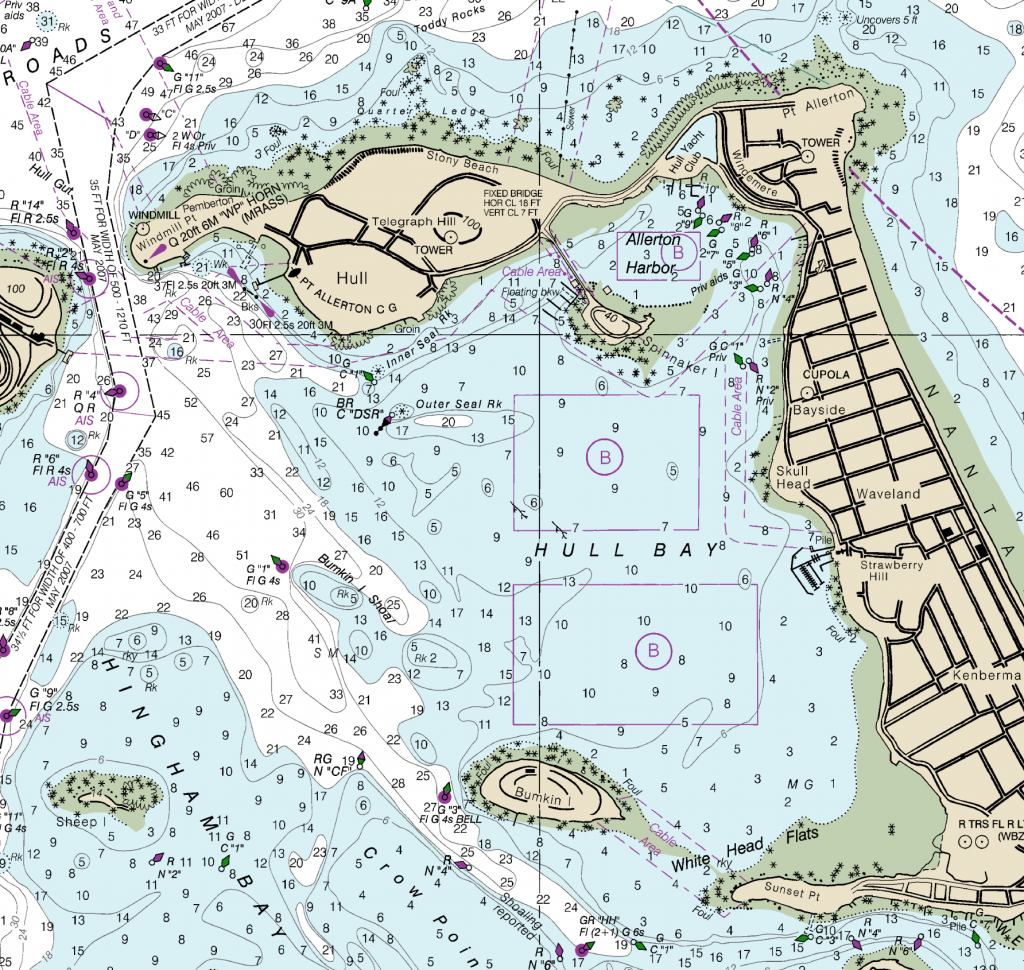2019 Rhodes 19 Nationals Recap
Published on .
Rhodes 19 #1926 finished in 3rd place at the 2019 Nationals in Hingham, MA with a crew of Nat Taylor, Jim Taylor and Yati McMahon. Our scoreline was 4-3-9-(10)-4-4-4-2. We were 2nd, 7th and 3rd after Day 1, 2 and 3 respectively. The Top 10 finishers were as follows and full results here.
| Name | Sail No. | Place | Points | R1 | R2 | R3 | R4 | R5 | R6 | R7 | R8 |
|---|---|---|---|---|---|---|---|---|---|---|---|
| Schreiber, Chris | 1680 | 1 | 14 | 2 | 7 | 1 | 1 | 3 | 2 | 2 | 3 |
| Nelson, David | 3172 | 2 | 28 | 6 | 4 | 10 | 6 | 7 | 1 | 3 | 1 |
| Taylor, Team | 1926 | 3 | 30 | 4 | 3 | 9 | 10 | 4 | 4 | 4 | 2 |
| Berkeley, Joe | 892 | 4 | 33 | 1 | 2 | 15 | 4 | 1 | 5 | SCP | 5 |
| Wilson Kaznoski | 2648 | 5 | 35 | 5 | 5 | 5 | 2 | 8 | 6 | OCS | 4 |
| Clancy, Steven | 1799 | 6 | 41 | 7 | 8 | 6 | 9 | 2 | 9 | 1 | 8 |
| Uhl, Steve | 2585 | 7 | 44 | 3 | 12 | 3 | 5 | 11 | 8 | 5 | 9 |
| Koskinas, Allison | 122 | 8 | 47 | 13 | 1 | 2 | 12 | 10 | 3 | SCP | 6 |
| Obersheimer, Charles | 957 | 9 | 68 | 15 | 6 | 8 | 3 | 19 | 15 | 8 | 13 |
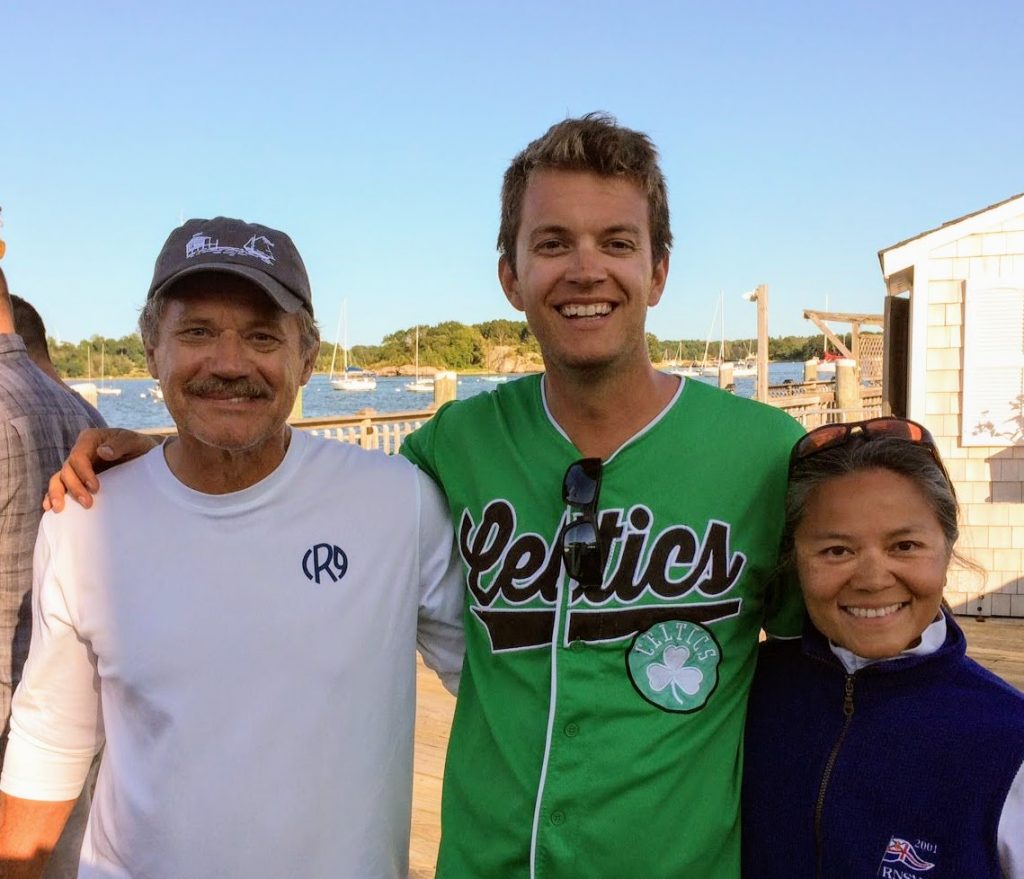
We are grateful to Hingham and Hull for hosting an awesome event, which included many social highlights including a pig roast! Hats off to the tireless folks who pulled off the most well attended Nationals in recent memory, with 36 competitors including 5 junior (under 25) boats! Also, huge thanks also to the Nancy and Rik Johnson for housing us.
Recap
We sailed the boat at around 475lbs crew weight with a 2017 Doyle mainsail, 2019 Doyle jib and a circa 2016 Doyle spinnaker. We made relatively few offseason modifications to the boat, so it was the setup we are used to with a mid-boom traveler, no jumpers and inboard jib tracks.
As always we learned a ton and have made some additions to our growing list of “dope slaps,” (the checklist-style document we maintain to remind ourselves to get the simple things right.)
We learned(/relearned) that downwind, it is better to err on having weight too far forward, compared to too far back since dragging ass is worse than bow-plowing, but as always important to listen to the gurgle and announce “back(/forward) a butt-width” accordingly.
We were reminded that big roll tacks are fast, maybe especially in flat water, and the key is rolling in unison and not before the jib backs.
We were reminded that patience is a virtue, and then getting antsy and over-tacking (which is usually is only possible in the middle of the course) is deadly in these underpowered little boats; instead it pays to play a side since that forces you to tack less.
We also did a full course current survey with a sponge, which was incredibly helpful even though there wasn’t much current on the course, since it eliminated an unknown and therefore made it easier to choose a race plan based on velocity without second guessing it for current.
Lastly, it is helpful for one crew to focus on announcing headings. That way even if you forget what phase you are in, you can likely deduce it by recalling the last couple of headings. Similarly, it is worth the time and weight for one crew to spend time cleaning up after mark roundings to ensure you’re prepared for the next mark. It’s also worth discussing the minute details of maneuvers, especially the stuff may seem obvious, to ensure everyone is ready.
There are some things I wish we did differently.
First and foremost is avoiding distractions. On Day 2, I was incredibly frustrated by my perception that 8-12 boats were egregiously over without only 1-2 sacrificial lambs getting called over; that we were sailing short W-L one-around that only took 30-minutes; and that the windward mark was tucked away under spinnaker island where it was incredibly fluky. While all of this was true, everyone had to deal with it, so by getting hung up on it we simply got distracted. In hindsight, I wish we would have let it all go and spent more time focusing on planning out our races. For example, before Race 2 we looked up and thought the right looked good, but the pin was so favored that we got started down there and got caught behind a boat reaching down the line; we should have followed our instincts and started closer to the boat where we’d have the freedom to tack, which the Schreibers did we great success.
That leads directly to the second thing, which is avoiding losing the forest for the trees. It is easy to forget that it’s not all that hard for a Rhodes 19 with clear-air to approximately double the boatspeed of one of who is pinching and fighting for a lane in a pack. As such, even with such short races and long biased lines, it was advantageous to start away from the pack, and therefore at the unfavored end, and make up the lost distance with boat speed. I wish we had Kattack to see just how big the speed differences were, but given how light it was and thus how extreme the “bubble effect” was, I would not be surprised it was it was 50%-100%.
I also wish we had a grease pencil to draw current lines on the chart, since we spent so much time taking readings (with a sponge.) I think this would have helped in certain scenarios, especially clueing into the fact that the left hand side was really good on Day 3.
Our proudest moments undoubtedly came on Day 3, when we broke our spinnaker halyard during the second race of the day, so had to do 5 bare-headed hoists and 2 bare-headed leeward mark roundings. Yati did an incredible job making that all go smoothly, such that we only lost a couple of boatlengths during each maneuver. We moved up from 7th to 2 points out of second mostly without a spinnaker halyard, which is a point-of-pride we will not soon forget.
Day 3’s 11-13kt breeze coming right off the land with no fetch for chop made for absolutely spectacular sailing conditions, especially as a relatively heavy boat. We rolled a 4-4-4-2 and were only ever behind a small handful of boats.
Racing Area
All of the races were held in Hull Bay. Low tide was at 10:38AM, 11:26AM and 12:18PM on each day respectively, so we primarily had incoming tide except for the beginning of racing on Saturday. Wind was were 8 @ 280°, 6 @ 320° and 12 @ 65° respectively. The current was a factor, especially at the windward mark on Day 1, but velocity and clear air were paramount.
Day 1 Race Log
Conditions: Low tide: 10:38AM; Wind: 8kts @ 280°;
Summary: Windward mark was in the current; boats were coming out from both corners; did a full current survey
R1 – Decent start; got fouled by 3234 at W1 (they spun) then approached L1 in about 5th; we should have–but didn’t–take room on 1799 at L1; no passing lanes upwind; got a favorable shift in the cone for W2 to pass 1799; On the first beat, #122 came out big from the right and #892 from the left.
R2 – Awesome pin end start and played the left, but once again #122 banged the right hand corner and lead; went +3 at W1 by jibing to the inside in a righty; over-estimated current at W2 and over-stood, thus giving up a point on #892.
Day 2 Race Log
Conditions: Low tide: 11:26AM; Wind: 6kts @ 320°;
Summary: Windward mark tucked behind Spinnaker Island, crazy pin favor all day, short lame one-lap 30 minute races; lots of reshuffling of mid-fleet boats getting top results
R3 – started second boat from the pin since it was left when we took a windshot at about 1:30, but must have been a big right shift late, because right punched out immediately and then there wasn’t much racecourse to play catchup
R4 – started close the pin but #122 reached down overtop of us and fouled us; leaders abandoned pin and just went for clean starts at the unfavored boat end and then went right; right favored again early, left late, maybe due to geography and condos above the top mark;
Day 3 Race Log
Conditions: Low tide: 12:18PM; Wind: 12kts @ 65°;
Summary: Amazing sailing day; only day with outgoing tide; breezy enough that by the time Yati finished cleaning up we were almost back to the windward mark.
R5 (one lap) – picked our hole late and really had to fight to get off the line (but that was the plan, to keep back off the line and burst with full speed); went right, got favorable late righty on the shy starboard layline in the cone to round 3rd, damaged spin halyard; coughed up 1 boat by jibing into the middle without pressure (oops)
R6 – started boat-third under 1799 and stayed on starboard until they started to roll us, then worked the upper right; rounded W1 in 3rd; had to do a bare headed hoist; rounded L1 in 1st to the unfavored gate (and had barely able to get kite down due to damaged cover) then coughed up Nelson, Clancy and Shreiber on the beat by letting the get left;
R7 – Late Vanderbilt-style start after making repairs, played left-middle then late right rounded W1 in 2nd (behind Nelson since we misjudged the layline); many close crosses with Shreiber; gapped a bit with a nice righty in the cone; gained by doing a bear-away hoist (everyone else jibed) then sailing to the favored gate.
R8 – all bare headed, eventually go ahead of Wilson after a long grind, but Dave came out of the top left slightly ahead and we could never pass him.
In Race 6, the second race of the day, the cover on our spinnaker halyard broke on the first run and after barely caming down at the leeward mark, it then wouldn’t go up at all for the next hoist so we had to do our first of 7 bare-headed sail changes. Crucially, on the second beat, we talked through what we’d do if it wouldn’t go up, so when it failed we were prepared and minimized our losses. In between Race 6 and 7, thanks to a long break for a course change, we frantically tried to run a spare spinnaker sheet through the mast to use as a halyard. The effort failed, and we were so distracted and that we missed the 5 minute and 4 minute warning signals, so we entered the starting box around 1:10. Somehow Yati caught the 1-minute warning and the competition left a big hole to barge through, so we were able to eek out a great start! Yati continued here heroics and we didn’t loose much distance overall. The key turned out to be overstanding the offset so we could drop the jib a moment early then do a (mostly) normal hoist. A bit of luck played in at the leeward mark, since we didn’t have any roundings where taking the kite earlier than desired could have cost us a lot.
Overall it was an awesome event!
Here are a few photos and a few other notes:
- The Shreiber family sailed an incredible event. Their scoreline is impressive, in part because they had to seriously grind for a bunch of those finishes.
- How ’bout the rising dynasty of the Kaznoski family? Wilson and Pete sailed tremendously well.
- Kudos to Fleet 46 for rising from the ashes and winning the Fleet Trophy with a 2-4-6!
- There were three boats that were basically in pieces just days before the event. RJ in 121 had his boat upside down on Tuesday, and had to cut 2.5″ off his mast on Wednesday before racing on Thursday. Jeff Kent recently redid his boat. Peter Sorlein’s hull restoration process was completed just in the time for Nationals, but there was about 36-hours man-hours worth of rigging and hardware work completed the week of the event!
- Hats off to Team Buffalo for their Top-10 finish. That’s amazing!

Pete had excellent post sailing attire 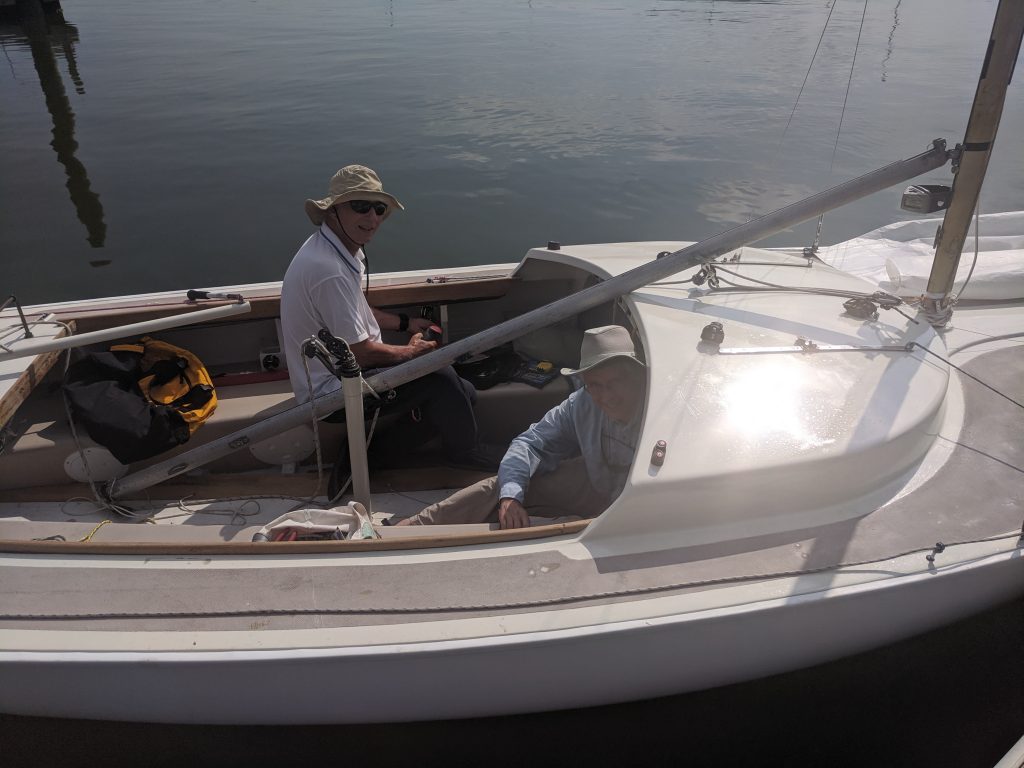
Peter was still drilling holes on Day 2 of the event! 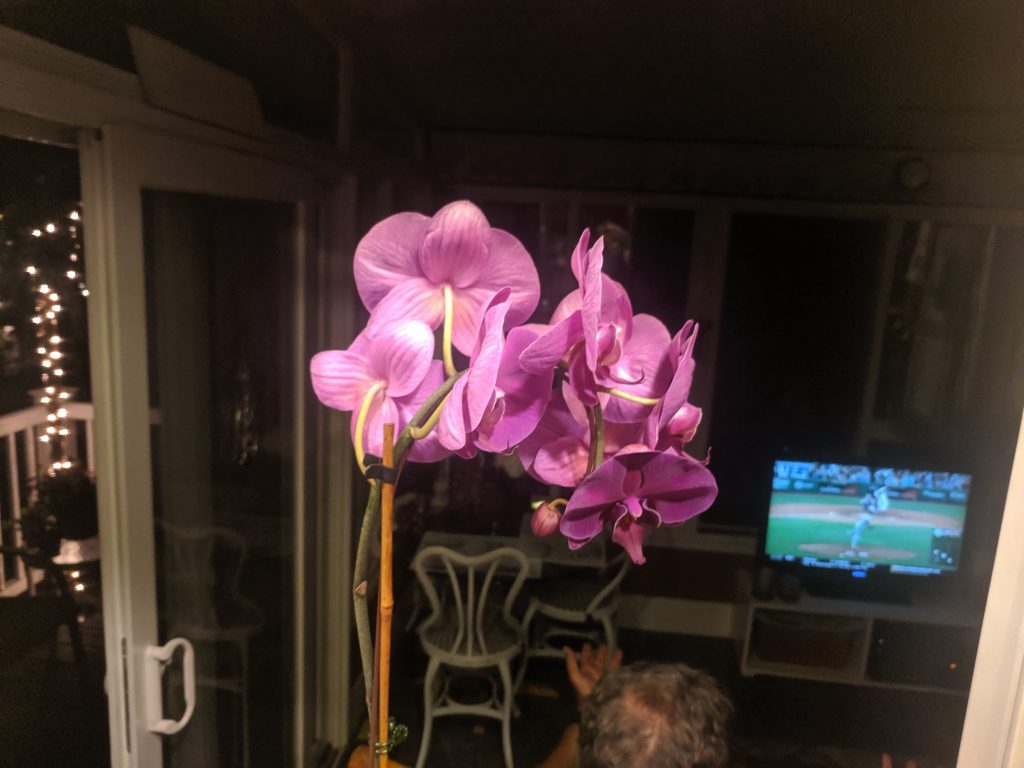
gift for your host family! 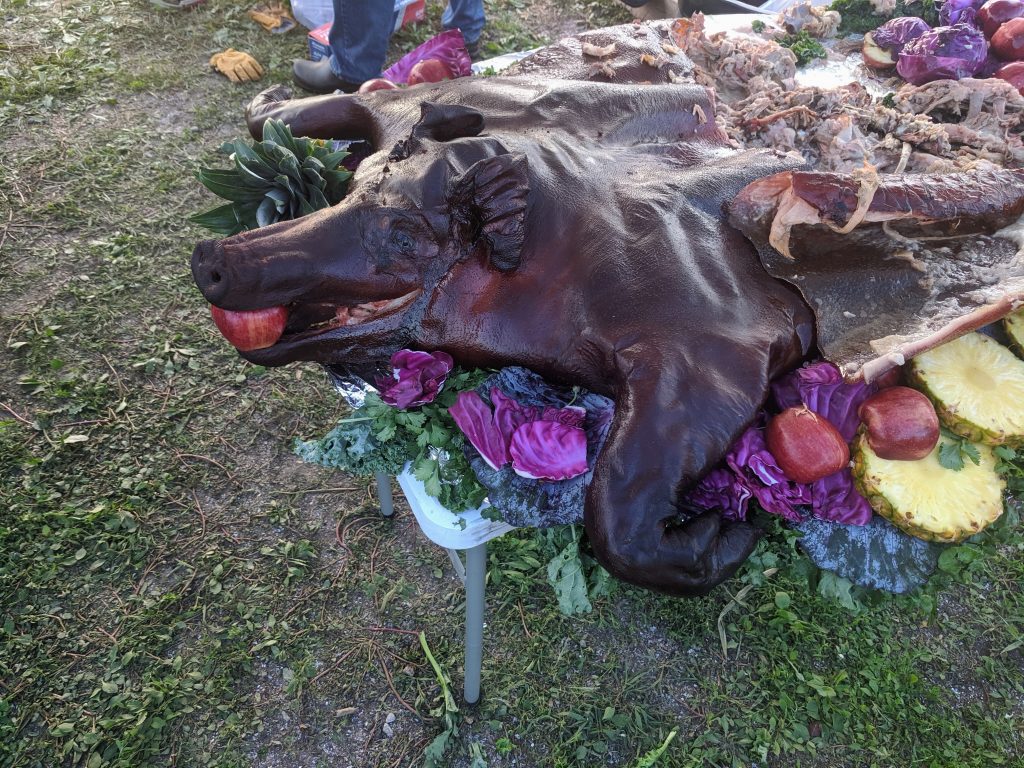
Pig roast!
